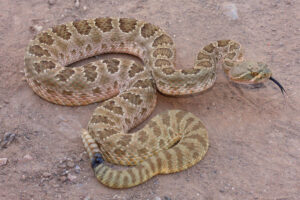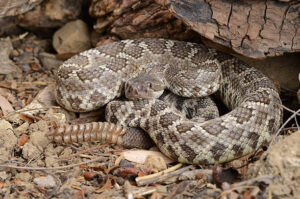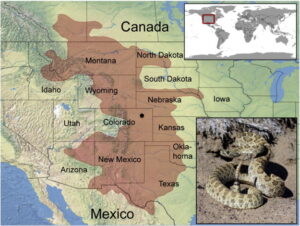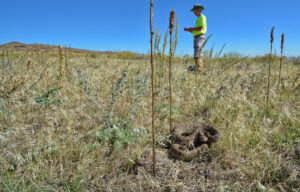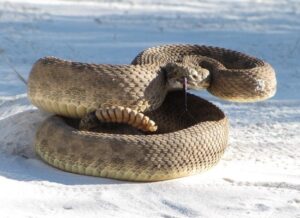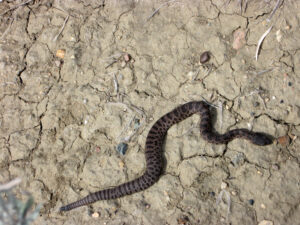The prairie rattlesnake or Great Plains rattlesnake is a highly venomous pit viper species endemic to the western United States, northern Mexico, and southwestern Canada. It is mainly terrestrial but occasionally climbs bushes or trees. Some even rest in caves and crevices. The snake is diurnal in cooler weather and nocturnal in hot weather.
Scientific Classifications
- Suborder:Serpentes
- Family:Viperidae
- Genus:Crotalus
- Species:C. viridis
Conservation Status
Subspecies
This snake has two recognized subspecies.
- Hopi rattlesnake (Crotalus viridis nuntius)
- Prairie rattlesnake (Crotalus viridis viridis)
Description
Size
Commonly, this species grows to more than 3.3ft (100 cm) in length. The maximum recorded size is 4.97ft (151.5 cm). Montana has some specimens exceeding 3.9ft (120 cm), with the species reaching its maximum size in this state.
Color and Appearance
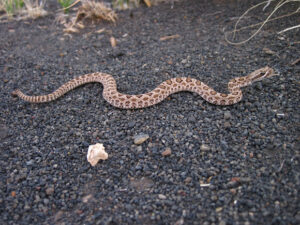
The snakes are usually lightly colored in shades of brown. The dorsal pattern often has patches of dark brown. A color band may be present at the back of the eye. It has a distinctive triangular-shaped head with pit sensory organs on either side. Its identifying feature is the presence of 3 or more, usually 4, internasal scales, two of which are in contact with the rostral.
Are They Dangerous to Humans
The species typically bite when threatened or injured. It has powerful venom, 20-55% of which is used in a single bite. The venom has both hemotoxic (muscle and tissue destroying) and neurotoxic (brain and nervous system damaging) effects. But before striking, it warns its attacker by rapidly vibrating its tail, producing a rasping sound unique to rattlesnakes.
The bite can cause swelling, severe pain, and bruising. There can also be nausea, difficulty in breathing, and disturbed vision. Severe cases can result in low blood pressure, shock, internal bleeding, and even death. So, medical attention needs to be sought soon after the snakebite.
Prairie Rattlesnakes at a Glance
Distribution
In North America, prairie rattlesnakes are found over much of the Great Plains, some intermontane valleys, and the eastern foothills of the Rocky Mountains, from southwestern Canada through the US to northern Mexico. In Canada, they live in Saskatchewan and Alberta; in the United States in most of Montana (where it is one of 10 snake species and the only venomous one), eastern Idaho, North Dakota, South Dakota, Nebraska, Wyoming, Colorado, Oklahoma, Kansas, Texas, New Mexico, extreme western Iowa, extreme southeastern Utah, northeastern Arizona; and in Mexico in northwestern Chihuahua and northern Coahuila. Its vertical range is from 330 ft (100 m) near the Rio Grande to over 9,104 ft (2,775 m) altitude in Wyoming.
Habitat
It mainly occurs in somewhat rocky regions, with the outcrops acting as den sites. It also occupies the burrows of other animals. The prairie rattlesnake seems to prefer dry areas with moderate vegetation coverage.
The pit viper prefers sinuosity while migrating, even in human-dominated environments, as it increases its chances of survival and ensures a better body condition during and post-migration.
Lifespan
The average lifespan of the pit viper is 16-20 years.
Predators
The prairie rattlesnake is preyed upon by raptors, carnivorous mammals, and king snakes.
Diet
The species prefers small mammals, like ground squirrels, rabbits, mice, rats and prairie dogs, and ground-nesting birds as its food. They occasionally eat reptiles, amphibians, and even other snakes.
Since they have poor eyesight, their heat-sensitive pits and forked tongue, capable of picking up airborne scents, are helpful adaptations for catching prey.
Reproduction
Viviparous (gives birth to live young)
The breeding season sees the males competing for the females, but the latter may not breed every year. In late summer or early fall, they give birth to 1-25 young in a brood, with an average of 4-12. The average number of young in a brood varies greatly with the environmental conditions and food availability. The venomous juveniles are 22-28 cm long and don’t need parental care. They reach sexual maturity at 3 years of age.
Similar Species
Western Diamondback Rattlesnake
Prairie rattlesnakes are thinner and longer than western diamondbacks, Crotalus atrox, that have flatter faces and larger patches. Plus, the latter has an even ratio of black and white stripes on the tail, near the rattle, while the ratio of white to black for the former is 2:1.
Timber Rattlesnake
Timber rattlesnakes, Crotalus horridus, have distinct black chevron-shaped patterns all along their backs. Their tails are velvet-black at the end with a light-colored rattle.
Bullsnake
A bullsnake, Pituophis catenifer, has round pupils, while the prairie rattlesnake has vertical ones. Plus, the former lacks heat-sensing pits above its nostrils, and the tail rattle.
FAQs
Ans. Being a medium-sized snake, the venom glands of the prairie rattlesnake are small and can produce only moderate amounts of venom. Also, its size is not big enough to drop a huge load of venom that can quickly kill a human. Plus, up to 20% of the time, it delivers a dry bite when no venom is injected. So though its bite has the potential to be fatal, fatalities are rare, with most people recovering completely with prompt medical attention.
Ans. No, prairie rattlesnakes are not aggressive. They don’t attack humans unless provoked.
Source
sdherps.org, wildlifepreservation.ca, projectnoah.org istockphoto.com, sciencedirect.com, adaptationenvironmental.com, nps.gov, flickr.com


